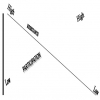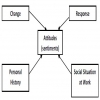Home | ARTS | Management Concepts & Organisational Behaviour
|
Pressures for Change - Organisational Change
Management Concepts & Organisational Behaviour - Organisational Change
Pressures for Change - Organisational Change
Posted On :
The need for change exists when the manager finds that the goals are not being achieved.
Pressures
for Change
The need for change exists when the manager finds that the goals are not being achieved. Thus, tension points in the organization are identified when the gap between the desired and the actual results is noticed. Such gaps could occur due to certain changes. In other words, these changes are precursors for organizational change, which are explained in the following pages.
Labor market Environment: one important aspect of labour market environment is the changing nature of the work force in terms of aspirations, outlook and various demographic variants. The work force composition is fast changing with increasing proportion of the woman, minorities, physically challenged. For instance, in India the work force diversity, of late is something unseen before. The present generation of work force wants quantification and seeks external reinforcement. Human resource management policies will have to change to attract, maintain a diverse work force. Increasing participation of woman means dual-career couples. So organizations have to change their transfer and promotional policies as well as provide child and elder care facilities. On the whole, there has been an increase in the formal education levels of work force. Modern businesses, therefore, have to redraw their human resources development plans and methods. Training programs need to be fine tuned aiming at upgradation of skills.
Technological developments: Changes in technology bring in their wake corresponding changes in the nature of the work. Computers, telecommunication systems, robotics, and flexible manufacturing systems, flexi time mode are some of the 21st century changes that have brought unimaginable changes at work place with respect to the time, comfort required for the execution of tasks. With changing technologies employees skills become obsolete. Hence, heavy investments become imperative. Modern control techniques substitute direct supervision which leads to wider spans and there by flat organizations. Information technology makes organizations more responsive to consumer demands. Narrow specialization in jobs gives way to work teams whose members perform multiple tasks and actively participates in group decisions.
Economic conditions: this is an age of discontinuity. To mention a few, oil shocks, accelerated inflation and interest rates, the stock market crashes, currency devaluation, etc., hit some industries and firms much harder than others. Globalization of markets is yet another significant change. The problem with these shocks is that it is impossible to predict what the future shocks will be and from where they come from.
Social Trends: High enrolment ratios are noticed in higher education. Higher education as a sector provides a mass market product. There is a changed composition of student community. Considerable proportion of woman students, part time students, outnumbering regular students has become the order of the day. Universities and colleges which fail to respond to these changes may find the going tough.
Work place diversity: Emergence of global markets, mobility of factors of production across the globe, integration of economic systems imposes certain demands on employees who have to interact with people in other countries and work with persons brought up in different cultures. Business organizations, therefore, have to prepare the work force which could perform and feel at home regardless of the place of work and the composition of work teams.
Competition: Competition is intensifying by the day in every product category. Businesses also in line with the changed realities and compulsions need to address themselves to the global context. Competitors may come from anywhere in the world, at times even from quite unexpected quarters. Heightened competition also means organizations need to defend themselves against traditional competitors and small entrepreneurial firms with innovative changes. Therefore, in order to meet competition, successful organizations in future rely on short production runs, short product cycles and a stream of innovative products. These will demand flexible work processes and schedules that can adapt to rapidly and even radically changing conditions.
The need for change exists when the manager finds that the goals are not being achieved. Thus, tension points in the organization are identified when the gap between the desired and the actual results is noticed. Such gaps could occur due to certain changes. In other words, these changes are precursors for organizational change, which are explained in the following pages.
Labor market Environment: one important aspect of labour market environment is the changing nature of the work force in terms of aspirations, outlook and various demographic variants. The work force composition is fast changing with increasing proportion of the woman, minorities, physically challenged. For instance, in India the work force diversity, of late is something unseen before. The present generation of work force wants quantification and seeks external reinforcement. Human resource management policies will have to change to attract, maintain a diverse work force. Increasing participation of woman means dual-career couples. So organizations have to change their transfer and promotional policies as well as provide child and elder care facilities. On the whole, there has been an increase in the formal education levels of work force. Modern businesses, therefore, have to redraw their human resources development plans and methods. Training programs need to be fine tuned aiming at upgradation of skills.
Technological developments: Changes in technology bring in their wake corresponding changes in the nature of the work. Computers, telecommunication systems, robotics, and flexible manufacturing systems, flexi time mode are some of the 21st century changes that have brought unimaginable changes at work place with respect to the time, comfort required for the execution of tasks. With changing technologies employees skills become obsolete. Hence, heavy investments become imperative. Modern control techniques substitute direct supervision which leads to wider spans and there by flat organizations. Information technology makes organizations more responsive to consumer demands. Narrow specialization in jobs gives way to work teams whose members perform multiple tasks and actively participates in group decisions.
Economic conditions: this is an age of discontinuity. To mention a few, oil shocks, accelerated inflation and interest rates, the stock market crashes, currency devaluation, etc., hit some industries and firms much harder than others. Globalization of markets is yet another significant change. The problem with these shocks is that it is impossible to predict what the future shocks will be and from where they come from.
Social Trends: High enrolment ratios are noticed in higher education. Higher education as a sector provides a mass market product. There is a changed composition of student community. Considerable proportion of woman students, part time students, outnumbering regular students has become the order of the day. Universities and colleges which fail to respond to these changes may find the going tough.
Work place diversity: Emergence of global markets, mobility of factors of production across the globe, integration of economic systems imposes certain demands on employees who have to interact with people in other countries and work with persons brought up in different cultures. Business organizations, therefore, have to prepare the work force which could perform and feel at home regardless of the place of work and the composition of work teams.
Competition: Competition is intensifying by the day in every product category. Businesses also in line with the changed realities and compulsions need to address themselves to the global context. Competitors may come from anywhere in the world, at times even from quite unexpected quarters. Heightened competition also means organizations need to defend themselves against traditional competitors and small entrepreneurial firms with innovative changes. Therefore, in order to meet competition, successful organizations in future rely on short production runs, short product cycles and a stream of innovative products. These will demand flexible work processes and schedules that can adapt to rapidly and even radically changing conditions.
Tags : Management Concepts & Organisational Behaviour - Organisational Change
Last 30 days 730 views














